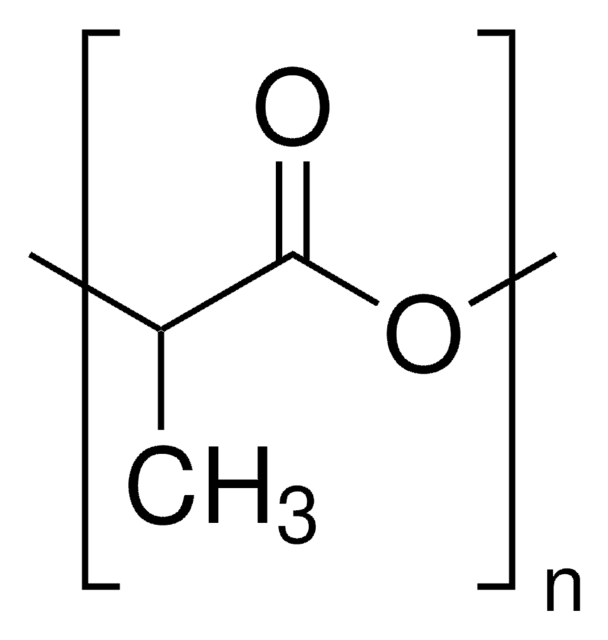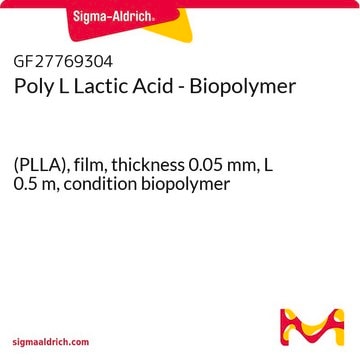Wszystkie zdjęcia(1)
Key Documents
38534
Polylactic acid
Mw ~60,000
Synonim(y):
Poly(2-hydroxypropionic acid)
Zaloguj sięWyświetlanie cen organizacyjnych i kontraktowych
About This Item
Polecane produkty
Postać
solid
okres trwałości
limited shelf life, expiry date on the label
masa cząsteczkowa
Mn ~30,000
Mw ~60,000
InChI
1S/C3H6O3/c1-2(4)3(5)6/h2,4H,1H3,(H,5,6)
Klucz InChI
JVTAAEKCZFNVCJ-UHFFFAOYSA-N
Szukasz podobnych produktów? Odwiedź Przewodnik dotyczący porównywania produktów
Opis ogólny
Polylactic acid(PLA) is a biodegradable polyester synthesized from lactic acid monomer via ring opening polymerization. Owing to its excellent thermal, mechanical and barrier properties, it is widely used in the field of tissue engineering, drug delivery, and orthopedic devices.
Zastosowanie
Polylactic acid can be used to prepare tubular scaffolds via the electrospinning method. These scaffolds are applicable in vascular tissue engineering.
It can be used to prepare PLA/polyvinyl alcohol wound dressing membrane through electrospinning and coating method. The coating of PLA improves the mechanical strength of nanofiber and acts as a protective layer to control the release of drug to the wound site.
It can also be used to synthesize free-standing, flexible ultra-thin PLA nanofilms which can act as a matrix for adhesion, spreading, and proliferation of skeletal muscle cells.
It can be used to prepare PLA/polyvinyl alcohol wound dressing membrane through electrospinning and coating method. The coating of PLA improves the mechanical strength of nanofiber and acts as a protective layer to control the release of drug to the wound site.
It can also be used to synthesize free-standing, flexible ultra-thin PLA nanofilms which can act as a matrix for adhesion, spreading, and proliferation of skeletal muscle cells.
Cechy i korzyści
- Biocompatibility
- Lower toxicity
- Low cost
- Better encapsulation
This page may contain text that has been machine translated.
produkt powiązany
Numer produktu
Opis
Cennik
Kod klasy składowania
11 - Combustible Solids
Klasa zagrożenia wodnego (WGK)
WGK 3
Temperatura zapłonu (°F)
Not applicable
Temperatura zapłonu (°C)
Not applicable
Środki ochrony indywidualnej
Eyeshields, Gloves, type N95 (US)
Wybierz jedną z najnowszych wersji:
Masz już ten produkt?
Dokumenty związane z niedawno zakupionymi produktami zostały zamieszczone w Bibliotece dokumentów.
Klienci oglądali również te produkty
Tong Chen et al.
Carbohydrate polymers, 92(2), 1124-1132 (2013-02-13)
Core-shell structured multifunctional nanocarriers (NCs) of ZnO quantum dots-conjugated gold nanoparticles (Au NPs) as core and amphiphilic hyperbranched block copolymer as shell were synthesized for targeted anticancer drug delivery. The amphiphilic hyperbranched block copolymer contained poly(l-lactide) (PLA) inner arm and
L Pearce McCarty et al.
The Journal of bone and joint surgery. American volume, 95(6), 507-511 (2013-02-15)
A variety of complications associated with the use of poly-L-lactic acid (PLLA) implants, including anchor failure, osteolysis, glenohumeral synovitis, and chondrolysis, have been reported in patients in whom these implants were utilized for labral applications. We report on a large
Zhenxing Fan et al.
Environmental technology, 33(19-21), 2369-2374 (2013-02-12)
Biological nitrate removal using wheat straw and polylactic acid (PLA) as both carbon source and biofilm support was investigated. The results showed that biofilm could develop on the surface of wheat straw within 15 d, the denitrification rate was 0.067
Discussion: Autologous fat grafting and injectable dermal fillers for human immunodeficiency virus-associated facial lipodystrophy: a comparison of safety, efficacy, and long-term treatment outcomes.
David Teplica
Plastic and reconstructive surgery, 131(3), 507-509 (2013-03-01)
Huan Zhou et al.
Materials science & engineering. C, Materials for biological applications, 33(4), 2302-2310 (2013-03-19)
Fibrous bionanocomposites consisting of amorphous magnesium phosphate (AMP) nanospheres and polylactic acid (PLA) were fabricated by electrospinning. There are two important signatures of this paper. First, AMP, as an alternative to well-known calcium phosphate (CaP) materials, is added to PLA
Nasz zespół naukowców ma doświadczenie we wszystkich obszarach badań, w tym w naukach przyrodniczych, materiałoznawstwie, syntezie chemicznej, chromatografii, analityce i wielu innych dziedzinach.
Skontaktuj się z zespołem ds. pomocy technicznej










